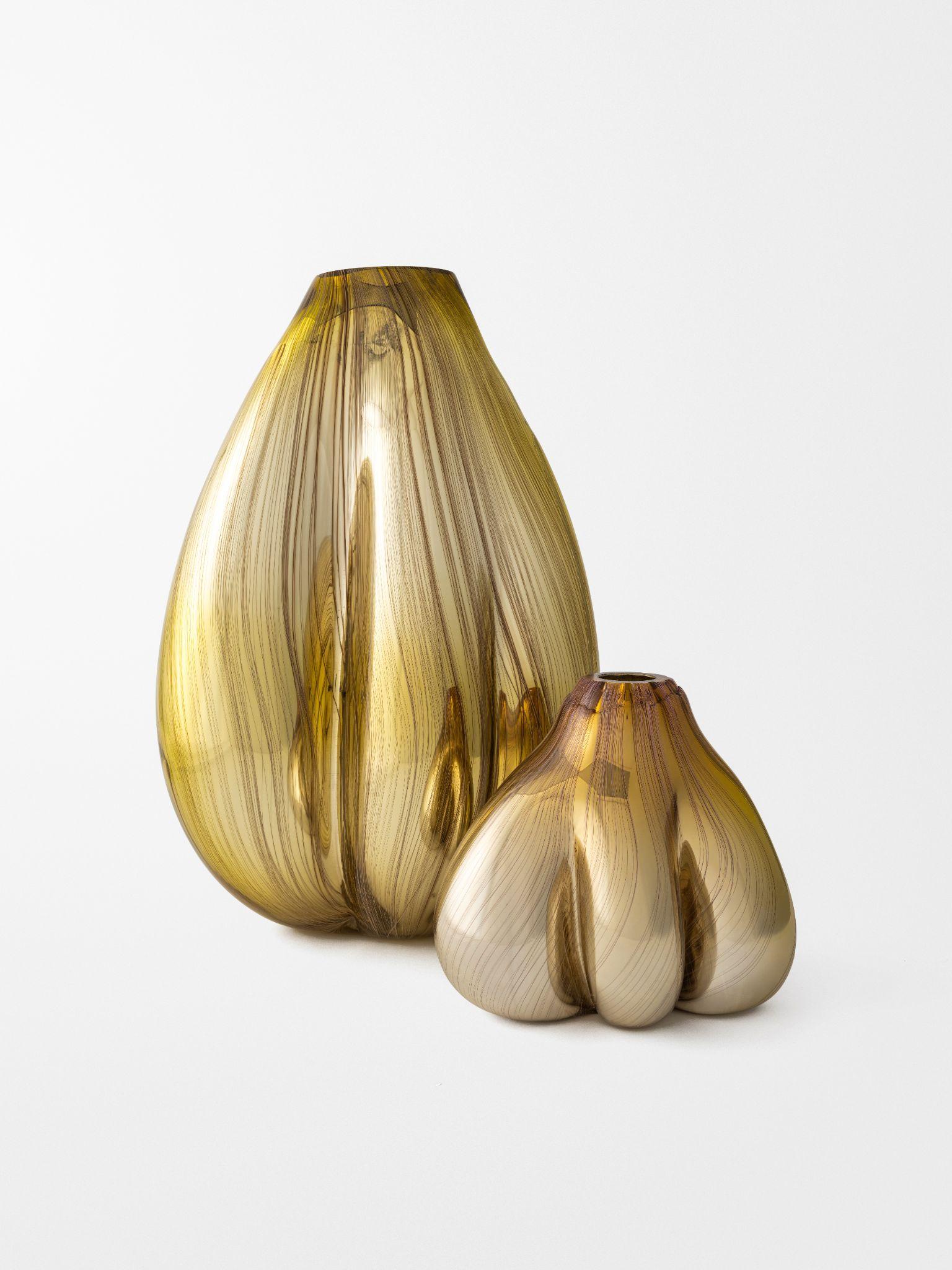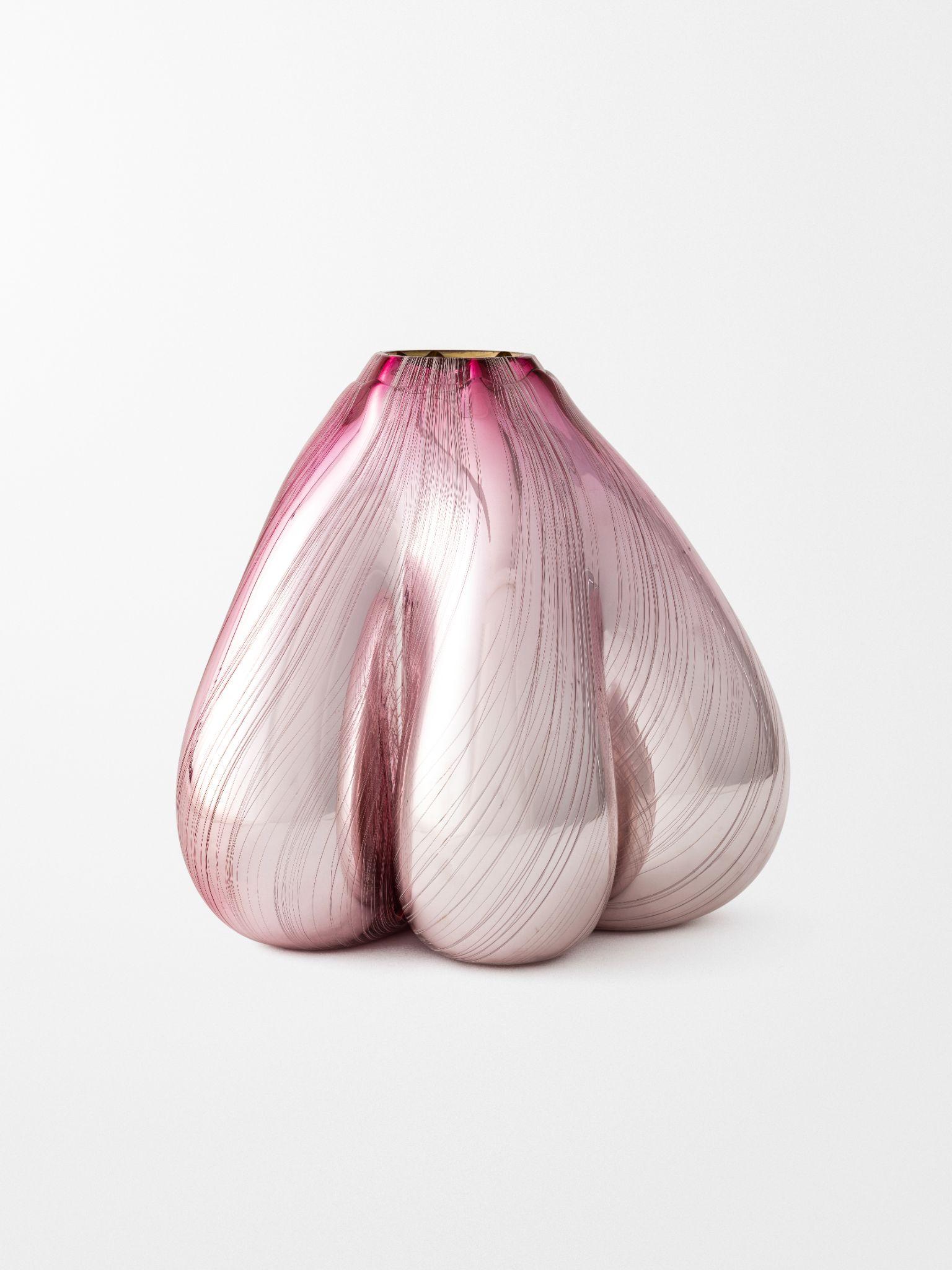George William Bell’s Lusty Anthropomorphism


Sumptuous, calm, and unknowable. The abstract forms populating Fluid Landscapes are striking in their technical proficiency, yet also poetically transfixing. Exploiting the open-ended nature of abstraction is the artist’s intention, leaving only the viewer’s unmediated experience as a reference to these outcomes of material investigation and design innovation. Evading categorization, George William Bell’s series of ellipsoid Abstract Form Studies, and protoplasmic totems of Self Generating Forms firmly stake their claim as bridges to a future, in which the limits of craft and design hold no sway.
Fluid Landscapes is Bell’s first exhibition with Chesterfield Gallery, New York, as well as Bell’s first solo presentation in the United States. Though born on American soil, the sculptor hails from the United Kingdom, attending university in Bornholm, Denmark where he continues to teach. The Danish art glass community celebrates Bell’s blown glass practice as one of their own. Currently, however, Bell is stateside, completing a residency program at Monterey GlassWorks in California.
It can be tempting to read the Abstract Form Studies as particular images, or to map one’s own intention onto the amorphous forms born out of Bell’s material investigation. Vegetal abstraction? Imaginative animalia? Lusty anthropomorphism? Organic abstractions may translate to eccentric cucurbits within the gourd family of curvaceous forms. Elegantly new-age icons, these distinct vessels may channel the silhouette of garlic plumes as instantiating philosophies of antioxidant immune-boosting wellness. But one’s imagination continues to cycle through a plethora of associations, unable to ground a figurative reading of the work.
These handheld vase-like forms claim a moment’s rest on the curving mirrored pedestals within the Chelsea gallery. Some four-lobed vessels appear seated in a kawaii stance, almost communicating as a pet might: eager to animatedly greet an owner. Other vessels with two lobes prominently tucked together, suggesting two arms propping up its weight while seated on its haunches.
Serene puffs of a surreal fantasy, these supple vessels drape like breasts. Soft shadows lead one’s eye along the ridge of a silken crevice. These beguiling, optimistically energized forms call out to be held, to be caressed. Demure in scale, seven of the Abstract Forms are studies for five larger-scaled statement pieces.
Although the most legible reading within these forms is that of gravity itself. Bell creates the opportunity for, as he expresses it himself in an interview “the material to define its own perimeters through the opposing forces of expansion from within, and [through] the natural cooling process of glass” caught as a frozen moment in its own right: an instantiation of the material’s own distilled “movement, transparency and fragility,” he continues.

Drawn into the enchanting luster of each surface, one is both welcomed onto its reflective plane, yet also distanced from its realm by nuanced washes of bronze or ruby. Upon closer inspection, encircling the neck of the vessel are swathes of chromatic tone rendering the surface more opaque to reflection, while the arching lobes reduce the viewer’s reflection to a slender miniature subsumed in spherical environs.
This is a masterful use of materials as the hollow vessels–from the nature of the glass blowing process–are silvered only upon the interior’s surface. Therefore, the areas of completely translucent glass on the exterior reveal the highest concentration of metallic reflection, which amplifies the broad tonality within the vessel’s central wall. Additionally, extremely delicate thin lines of color (applied as a cold worked cane technique) transverse the surface in its entirety: unifying these distinct planes. Hints of white, pink, or chestnut appear to inhabit distinct depths, revealing and disappearing to different effects on their journey across the face of the form.
As a final stroke of mastery of materials, George William Bell dips the entire form in a substantial final coat of clear glass. Both risky in terms of managing the temperature differential between the cooling blown vessel and the fiery molten glass within the furnace, but also in terms of the physical dexterity required of the motion for dipping to avoid the inclusion of air bubbles trapped upon the inverted form. For the larger-scaled Abstract Forms, when still mounted on the pipe, the weight and mass of the form can be unwieldy, increasing the risk of miscalculating the maneuver. If the piece were to fall into the furnace at the last stage of the process, its overall tone and color caning would contaminate the entire batch of otherwise pure translucent glass used during the originating gather for all future works, much like a baker’s starter.


Fighting the need for perfection–as factory production glass designs require–Bell leaves the traces of this final dip as a hallmark of the object’s triumph as well as serving as a high watermark of tension between two realms that shall never meet. Leaving these centimeters of unglossed surface at the mouth of the vessel becomes akin to a fingerprint identifying it as a unique creation. The gesture of leaving these apertures uncut, as it were, increases their familiarity as nearly cellular entities. Certain larger-scale Abstract Forms bare trace patterns evoking streaks of rain or runs of tears, bearing witness of the process of how the interiors are silvered with a metallic sheen. It is yet another aspect of the work’s capacity to bear emotive meaning that connects the object with the fragility of our own humanity. The energetic interplay achieved in the wake of the high noon solar rays truly activates these works into a life of their own, almost as if they are distinct living beings in their own right.
Rarely do experiments in design production touch upon our core humanity. Yet, George William Bell’s attempts to push forward his given medium of blown glass, arrive at outputs seeping with soulful vitality. Often considerations of how industrial form can expand upon the ways materials are manipulated—repeatable formulaic interventions of minute variation—often produce cold objects of aesthetic chic. Fulfilling the modernist credo of streamlined functional forms, this materials-first approach leaves a trail of one-note creations. However, Bell approaches glass entirely as an extension of the body itself, incapable of severing its linkage to the humanity that forged it from the fires of the furnace.
Deeply considering these works not only rewards the viewer in surfacing numerous layers of visual engagement, but also establishes an interconnected exploration of oneself; through a push and pull of distancing the immediacy of physical reflection, of tapping upon one’s subconscious desires, and then of excavating one’s true nature as your eyes trace along the contours of the surface.

The columnar Self Generating Forms reveal their shape as gravity’s imposition on the molten glass in a singular direction, therefore it is a series exploring height as a temporal characteristic. The bubble-like protrusions are individual globs of molten glass applied to the surface of the chromatic interior form. The thick plasma-like layer of the final dip is applied to these forms as well. Yet here in tandem with the magnifying capacity of each node, this translucent coating manipulates the passage of light through the various layers creating the sense of a highlight or an aura surrounding the work. The spontaneity and frisson of the creation maintains a strong energetic identity within the finished work, as adhering to small nodules of molten cut glass necessitates swift action due to the high heat and extreme malleability of the materials. Therefore imbuing these innovative objects with a palpable personality–some quirky, some cute, some animated, some biomorphic. This energetic tone of molten materiality is similar to the Venetian modernist rostrato technique, yet the additional encasement of the form—as if lacquered—concludes the thought, as if Bell places a soothing period at the end of the cheeky, quick-witted phrase.
The achievements of the work are sufficient to develop a personal relationship to the unique objects, an intimate engagement with one’s own human nature, but also to raise questions of the nature of design innovation. Living in a technology-saturated epoch, what do future-looking, inquiry-centered designs look like? Can IRL analog objects vie for an authentic claim to transformative innovation in the age of new media, where digital interfaces reign architecturally unchallenged in museums, immersive experiences, NFT markets, and advertising at large? George William Bell, as a global citizen and millennial, firmly advocates the role of the artist as an expert hyphenate creator: equal parts technical impresario, hand-crafted designer, and conceptual sculptor. Therefore, Fluid Landscapes defines the design objects of tomorrow by their ability to tie material understanding to resourcefulness, transformation, sustainability, and experimentation, all the while not forsaking the distinct capacities of our desire to discover what connects us fundamentally as human beings.
George William Bell: Fluid Landscapes is open through May 11th, 2023 at Chesterfield Gallery’s High Line Nine space in Chelsea, NY, and can be viewed as a 3-D tour online.
You Might Also Like
Artistry Abounds in “New Glass from Sweden” at Culture Object
Will Benny Or Innovate Environmental Design in the Art World?
What's Your Reaction?
Carson Woś is a researcher, writer, and arts administrator. Her research interests include fiber art, global feminisms, and architectural sustainability, and she is a contributor to Cultbytes and Artspiel. Currently, the Development Officer for The Immigrant Artist Biennial and Partnerships Director at Seminal. Woś has held previous positions at Artnet, Hampton Court Palace, Metropolitan Museum of Art, MoMA PS1, and Creative Capital. Woś holds an MA in Decorative Arts, Design History, and Material Culture from Bard Graduate Center, and an MA (Hons) in Art History from University of St Andrews in Scotland.

